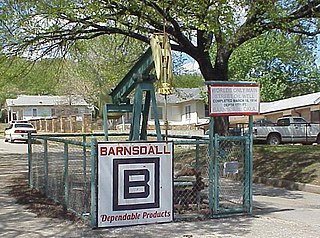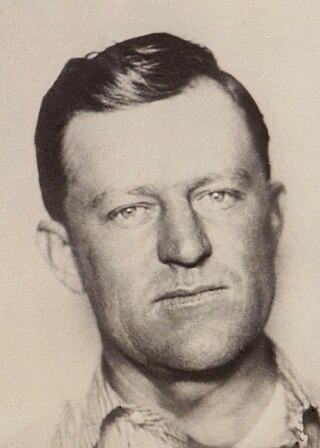Related Research Articles

Osage County is the largest county by area in the U.S. state of Oklahoma. Created in 1907 when Oklahoma was admitted as a state, the county is named for and is home to the federally recognized Osage Nation. The county is coextensive with the Osage Nation Reservation, established by treaty in the 19th century when the Osage relocated there from Kansas. The county seat is in Pawhuska, one of the first three towns established in the county. The total population of the county as of 2020 was 45,818.

Barnsdall is a city in Osage County, Oklahoma, United States. As of the 2020 census, the population of the city was 1,034.
Burbank is a town in western Osage County, Oklahoma, United States. The population was 141 at the 2010 census, a 9 percent decrease from the figure of 155 recorded in 2000.
Fairfax is a town in Osage County, Oklahoma, United States. The Osage Nation reservation is coterminous with the county. The population was 1,380 at the 2010 census, down 11.3 percent from the figure of 1,555 recorded in 2000. It was the home of the ballerinas Maria and Marjorie Tallchief.
Hominy is a city in Osage County, Oklahoma, United States. The population was 3,565 at the 2010 census, a 38 percent increase over the figure of 2,584 recorded in 2000.

Pawhuska is a city in and the county seat of Osage County, Oklahoma, United States. As of the 2020 census, the population of the city was 2,984. It was named after the 19th-century Osage chief, Paw-Hiu-Skah, which means "White Hair" in English. The Osage tribal government, which opened offices in Pawhuska in 1872 when its reservation was established in Indian Territory, continues to be based in Pawhuska.

The Osage Indian murders were in Osage County, Oklahoma, during the 1910s–1930s. Newspapers described the increasing number of unsolved murders and deaths among young adults of the Osage Nation as the "Reign of Terror". Most took place from 1921 to 1926. At least 60 wealthy, full-blood Osage persons were reported killed from 1918 to 1931. Newer investigations indicate that other suspicious deaths during this time could have been misreported or covered-up murders, including those of individuals who were heirs to future fortunes. Further research has shown that the death toll may have been in the hundreds.

The Osage Nation is a Midwestern American tribe of the Great Plains. The tribe began in the Ohio and Mississippi river valleys around 700 B.C. along with other groups of its language family, then migrated west in the 17th century due to Iroquois incursions.

The Joseph H. Williams Tallgrass Prairie Preserve, in Osage County, Oklahoma near Foraker, Oklahoma, is the largest protected tract of tallgrass prairie in the world. Managed by The Nature Conservancy, the preserve contains 39,650 acres (160 km2) owned by the Conservancy and another 6,000 acres (24 km2) leased in what was the original tallgrass region of the Great Plains that stretched from Texas to Manitoba.
Gray Horse is an unincorporated community in Osage County, Oklahoma, United States. The post office was established May 5, 1890, and discontinued December 31, 1931. It was named for Gray Horse (Ko-wah-hos-tsa), an Osage medicine man.
The Midland Valley Railroad (MV) was a railroad company incorporated on June 4, 1903 for the purpose of building a line from Hope, Arkansas, through Muskogee and Tulsa, Oklahoma to Wichita, Kansas. It was backed by C. Jared Ingersoll, a Philadelphia industrialist who owned coal mining properties in Indian Territory. The railroad took its name from Midland, Arkansas, a coal mining town in western Arkansas, which was served by the railroad. The Midland Valley gained access to Fort Smith, Arkansas via trackage rights over the Frisco from Rock Island, Oklahoma.

William King Hale was an American political and crime boss in Osage County, Oklahoma, who was responsible for the most infamous of the Osage Indian murders. He made a fortune through cattle ranching, contract killings, and insurance fraud before his arrest and conviction for murder.

John Joseph Mathews became one of the Osage Nation's most important spokespeople and writers of the mid-20th century, and served on the Osage Tribal Council from 1934 to 1942. Mathews was born into an influential Osage family, the son of William Shirley Mathews an Osage Nation tribal councilor. He studied at the University of Oklahoma, Oxford University, and the University of Geneva and served as a pilot during World War I.

Fred Lookout was an Osage Nation politician who served several terms as the principal chief of the nation. Lookout served as principal chief three times: 1913–1914, 1916–1918, and from 1924 until his death in 1949.
United States v. Ramsey, 271 U.S. 467 (1926), was a U.S. Supreme Court case in which the Court held that the government had the authority to prosecute crimes against Native Americans (Indians) on reservation land that was still designated Indian Country by federal law. The Osage Indian Tribe held mineral rights that were worth millions of dollars. A white rancher, William K. Hale, devised a plot to kill tribal members to allow his nephew, who was married to a tribal member, to inherit the mineral rights. The tribe requested the assistance of the federal government, which sent Bureau of Investigation agents to solve the murders. Hale and several others were arrested and tried for the murders, but they claimed that the federal government did not have jurisdiction. The district court quashed the indictments, but on appeal, the Supreme Court reversed, holding that the Osage lands were Indian Country and that the federal government therefore had jurisdiction. This put an end to the Osage Indian murders.

The Osage Nation operates seven casinos in Oklahoma, under the name Osage Casinos. The 25th largest tribe in the United States, the people are based on their reservation encompassing Osage County, Oklahoma. It is larger than the U.S. states of Delaware and Rhode Island.

Geoffrey M. Standing Bear (Osage) is an attorney and politician who has served as Principal Chief of the Osage Nation since 2014.
An Osage headright is a type of headright in the United States. There are 2,229 Osage headrights, one for each member of the Osage Nation enrolled in 1906. Osage headrights entitle the owner to a quarterly share of the Osage Mineral Estate.

Ernest George Burkhart was an American murderer who participated in the Osage Indian murders as a hitman for his uncle William King Hale's crime ring. He was convicted for the killing of William E. Smith in 1926, and sentenced to life imprisonment. Burkhart was paroled in 1937, but was sent back to prison for burglarizing his former sister-in-law's house in 1940. After being paroled for the final time in 1959, Burkhart was pardoned by Oklahoma governor Henry Bellmon in 1966 for his role in the Osage murders.

Bacon Rind was an Osage politician who served as Principal Chief of the Osage Nation between 1912 and 1913. He also served on the assistant chief between 1904 and 1905 and served on the tribal council.
References
- 1 2 3 May, Jon D. "Million Dollar Elm". okhistory.org. Encyclopedia of Oklahoma History and Culture . Retrieved 7 December 2023.
- ↑ "Did You Know?". Osage Nation. 26 March 2014. Retrieved 7 December 2023.
- ↑ "Million Dollar Elm". aoghs.org. American Oil and Gas Historical Society.
- 1 2 3 Duty, Shannon Shaw (6 May 2024). "Osage News investigates the mystery of the Million Dollar Elm". KOSU . Osage News. Retrieved 9 May 2024.
- ↑ Brinkman, Bennett; Savage, Tres; Loveless, Tristan (6 May 2024). "Roundup: Poll talks Stitt, state favorability; McGirt to be released; Walters answers lawsuit". NonDoc. Retrieved 9 May 2024.
- ↑ Sharfman, Alexandra (1 May 2024). "Decade old symbolic Million Dollar Elm cut down; Osage Police suspect vandalism". KTUL . Retrieved 1 May 2024.